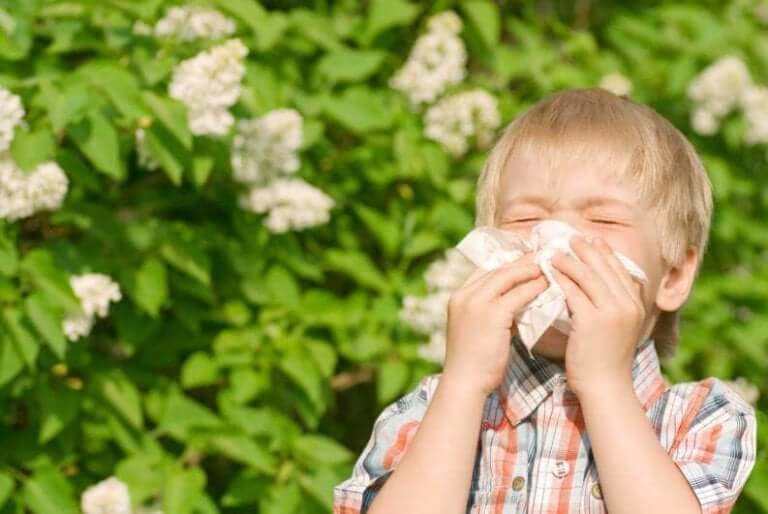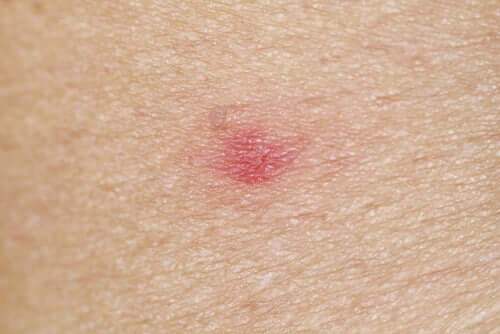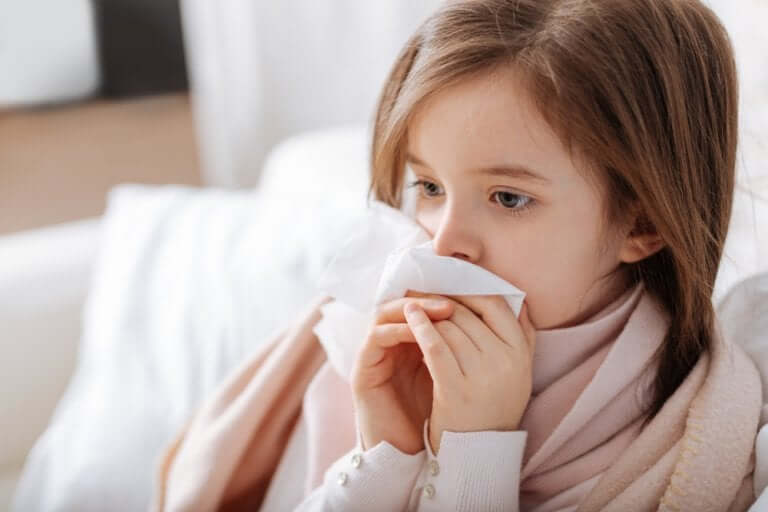The 9 Most Common Allergies in Kids

Allergies occur when the immune system defends the body in an exaggerated way. Usually, they attack something that isn’t harmful. Allergies are very common in childhood. In this article, we’ll show you the 9 most common allergies in kids.
A modern condition

Allergens are the elements or substances that cause allergic reactions. Normally, there’s no reason for the immune system to react that way. However, once that immediate hypersensitive reaction occurs, every time the person makes contact with the allergen, the same thing happens.
Allergies usually develop in childhood. Children with parents or siblings that have allergies will most likely develop allergies. However, they might not react in the same way. Additionally, they might not react to the same allergens.
Interestingly, our parents and grandparents were much less allergic than our children. In fact, the most common allergies are a result of modern life. Lifestyle, unhealthy foods, and pollution have made allergens spread. According to the U.S. Center for Disease Control, in the last 20 years alone, the percentage of children with food allergies has grown by 50%.
Why is this?
Believe it or not, the reason is obvious. Past generations ate more fresh foods. Nowadays, our foods are processed with chemical additives. Additionally, they ate more organic foods than those treated with pesticides and fertilizers.
Similarly, respiratory allergies have gotten worse due to environmental pollution. Climate change has altered the pollen production cycle of plants. Also, using chemicals at home in personal hygiene has made allergies worse.
The most common allergies in kids
The category of “most common allergies” varies according to the allergens. Whether children or adults, those that suffer from allergies have contact with allergens through food, breathing or skin. That said, here’s our list of the most common allergies in kids:
1. Dust mites
Dust mites are one of the most common allergens. In fact, these microscopic insects live all around us. They build up in mattresses, pillows, carpets, and stuffed animals. They feed on dead skin cells.
Routine cleaning is essential to stop them from growing and spreading. Therefore, ventilate the environment frequently to reduce dust buildup and prevent mites.
Read more: Dust Mites? Kill Them Safely and Naturally
2. Pollen
Pollen is another main allergen. These allergies are seasonal since every tree, shrub and even grass give off pollen particles that travel in the air to fertilize others. You can be allergic to different types of pollen, although one of the most common and irritating is grass pollen. These plants are mainly herbaceous, like wheat, oats or barley. Due to their great resistance, they can grow in all kinds of environments. However, they are more common in more rural areas.
Currently, you can check the status of pollen in the air from numerous sources. You can find them on your city web pages or weather sites.
3. Most common allergies in kids: Mold
Mold is another common allergen at home and lots of places where children live. It’s a type of fungus that grows in hot and humid environments. This fungus gives off a characteristic smell. Also, its spores produce reactions in the body.
4. Pets
Our beloved pets are triggers of many allergies. Fur, skin, dandruff, saliva and even urine from animals can cause allergic reactions in children.
5. Cockroaches
Cockroaches are potent allergens in cities. In fact, exposure to these creatures in cockroach-infested buildings can be the source of asthma. Usually, chemical insecticides can make this allergy worse. In fact, these make the symptoms worse and don’t do much to control the insects.
6. Food
Some of the main foods that cause these allergies are:
- Cow’s milk
- Eggs
- Seafood products, like fish, shellfish, and mollusks
- Nuts, such as peanuts, hazelnuts, walnuts, almonds, and cashews
- Soy
Also, there’s confusion surrounding wheat and gluten. People are not allergic to gluten in wheat, but rather intolerant. That inability to digest gluten is what’s known as celiac disease.
7. Insect bites

Insect bites cause swelling, itching, and redness in many children. Allergies to insect venom can cause severe reactions. Additionally, they could even put children’s life at risk.
8. Medications
Both over-the-counter drugs in pharmacies and prescription medications can cause allergic reactions. Also, antibiotics are a part of this group. Therefore, it’s important to not use any medication without consulting your doctor.
It’s a good idea to carry some type of identification if you have an allergy to a medication. There are bracelets and necklaces for people allergic to penicillin, atropine or adrenaline, especially because of the risk in emergency situations.
9. Most common allergies in kids: Chemical products
Certain detergents, cosmetic products or cleaning products we use at home are one of the most common allergies in kids. The chemical components of these products are responsible. Also, they can be irritating to the respiratory tract or skin.
In the most extreme cases, anaphylaxis may occur. This is the rapid and intense defense of the body when it senses an allergen. In fact, this can be fatal.
You might be interested: Everything You Need to Know About Allergy Shots
Symptoms of the most common allergies in kids

The symptoms depend on how sensitive you are to an allergen. Some allergies are more intense than others. Therefore, if your child has any of these symptoms, it’s best to consult your pediatrician. You might need to do different tests so you can determine what type and degree of allergies affect you or your child.
Symptoms of respiratory allergies
- Sneezing
- Coughing
- Itchy nose or throat
- Nasal congestion or rhinitis
- Redness and itchy eyes
- Asthma, wheezing and breathing difficulties
Symptoms of food allergies or insect bites
- Itchy mouth or throat when swallowing food
- Urticaria
- A rash similar to eczema
- Itchy nose and throat
- Shortness of breath
- Swelling around the face or throat
- In the most severe cases, children may go into shock
Final considerations regarding the most common allergies in kids
Many children will overcome their allergies early. However, others will live with them for the rest of their lives. Parents are crucial in teaching children to identify and prevent contact with the allergens that affect them.
No matter what, it’s important to avoid self-medication. Also, be careful when cleaning and don’t use chemicals at home. Your children’s health will benefit.
All cited sources were thoroughly reviewed by our team to ensure their quality, reliability, currency, and validity. The bibliography of this article was considered reliable and of academic or scientific accuracy.
- Alché, Juan de Dios, and M. I. Rodríguez García. “El polen como vector responsable de alergias.” (1997).
- Belmonte, Jordina, et al. “Aerobiología y alergias respiratorias de Tenerife.” (2010).
- Villafane, Claudia Acevedo, et al. “Influencia de la lactancia materna y la alimentación en el desarrollo de alergias en los niños.” Atención primaria 41.12 (2009): 675-680.
- Clínica Mayo. Dust mite allergy. (2019). Recuperado el 22 de septiembre de 2020. https://www.mayoclinic.org/diseases-conditions/dust-mites/symptoms-causes/syc-20352173
- Australian Society of Clinical Immunology and Allergy. Pollen Allergy. (2019). Recuperado el 22 de septiembre de 2020. https://www.allergy.org.au/patients/allergic-rhinitis-hay-fever-and-sinusitis/pollen-allergy
- Asthma and Allergy Foundation of America. Mold Allergy. (2015). Recuperado el 22 de septiembre de 2020. https://www.aafa.org/mold-allergy/
- American College of Allergy, Asthma and Immunology. Cockroach Allergy. Recuperado el 22 de septiembre de 2020. https://acaai.org/allergies/types/cockroach-allergy
- Clínica Mayo. Food Allergy. (2019). Recuperado el 22 de septiembre de 2020. https://www.mayoclinic.org/diseases-conditions/food-allergy/symptoms-causes/syc-20355095#:~:text=Food%20allergy%20is%20an%20immune,problems%2C%20hives%20or%20swollen%20airways.
-
Kimber I, Basketter DA, Dearman RJ. Chemical allergens–what are the issues? Toxicology. 2010 Feb 9;268(3):139-42. doi: 10.1016/j.tox.2009.07.015. Epub 2009 Jul 29. PMID: 19646501.
This text is provided for informational purposes only and does not replace consultation with a professional. If in doubt, consult your specialist.








